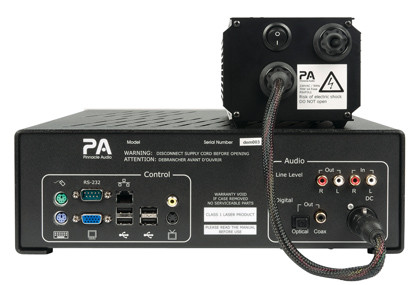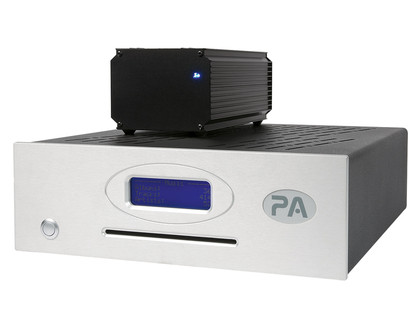TechRadar Verdict
A well-built server with a nice interface and decent enough sound via its digital output, but whether this can tempt audiophiles looking for a competitive server system from the available alternatives is hard to say
Pros
- +
Easy to set up
- +
Good touch screen web tablet operating interface
- +
High build quality
- +
Decent digital output quality
Cons
- -
A little dull-sounding on its own
- -
Needs connection to a router
- -
There's no fixed level analogue out
- -
Short PSU lead
Why you can trust TechRadar
Music servers were once the preserve of custom installed systems, being more at home with speakers in the ceiling, motorised projector screens and outrageous price tags – but things are changing. Thanks to the iPod, we all want easy access, having our entire music collection in a single device, for instance. Enter then, a new breed of server in the form of the Pinnacle Audio Folio music server.
Of course, it does have to compete with the mighty iPod itself, which when plugged into a suitable dock forms a small, ergonomic and versatile music server. We looked at examples from Wadia and MSB last year, both of which attempt to raise the audio standard that can be achieved and in many respects this is what newcomer Pinnacle Audio is up against with the Folio music server.
The Folio is an attractively cased server that comes in three alternative drive sizes: 250GB, 500GB and 750GB, with the price per gig coming down as the HDD expands (note that prices are due to go up at the end of March).
RAID equipped
Being RAID devices, they have two HDDs onboard – one acting as a back-up should the main one fail. This is something you don't get with an iPod in the full sense, although the chances are the music will have been loaded from a PC where it might still reside.
The Folio is controlled by a web tablet, in this case a Nokia N810, a slick and compact device with a touchscreen and a hidden keyboard that you can use to quickly search for a track. It controls the player via your Wi-Fi router, so the Folio also has to be connected to the same router with an ethernet cable.
You could put a wireless bridge on the back of the Folio, but Pinnacle prefers the reliability of a cable. This link also allows you to take music from the PC and for the device to update itself automatically over the web.
Sign up for breaking news, reviews, opinion, top tech deals, and more.
This system might seem complex, but it does mean you can control the Folio with a high-quality touchscreen interface like the Nokia – you can easily pay more than the price of this server for a multi-room style interface from AMX or Crestron, so it seems quite good value.
Pinnacle is looking to replace the Nokia with an Arcos Android device next year and this will be able to upload the music on the HDD and operate as an MP3 player, among other features.
On the formats front, it supports WAV, FLAC, Ogg Vorbis and MP3 at between 128 and 320kbps, while a format option tells you what the pros and cons are. FLAC appears to be the favourite. WAV is described as offering no quality gain over FLAC and is therefore not recommended.
The interface takes a bit of getting used to, but once mastered you can do most things by using your finger rather than the stylus. It's quite easy to assemble a play list or just play an album, and once you understand that it won't play the rest of the album if you select just one track, you're away.
Getting an album onto hard disk is as simple as pushing it into the slot drive – the system will rip it and find title info and album art via the router. Pinnacle's aim with this product is to make servers simple and on this level they have certainly succeeded.
Beside the main unit, the Folio has a separate linear power supply in a chunky case with a short lead – so short you'll need to put it on the same shelf or very nearby. Apparently, this cable has to be short because it reduces the amount of regulation required in the player itself.
Audio connections extend to analogue in and out (variable) plus digital out on coax and optical sockets. There are also two USBs, an S-Video output for a monitor and connectors for multiroom installation.

Sound quality
Being aware that audio enthusiasts are loth to involve computers with sound systems, Pinnacle has made set up very straightforward. Pretty well all you need to do is remember the password for your Wi-Fi router and type this into the web tablet when prompted.
Allowing the Folio to browse the music you have on your computer is slightly less obvious, but easy really, even if you're a technophobe. And, of course, you don't need to do this at all if you just want to load discs onto the drive itself.

Usefully, it can burn copies of playlists or albums for you, but is less useful when it comes to telling you when a disc's worth has been amassed – rather it will ask for another blank disc once it has loaded the first. We loaded up a number of familiar albums onto the Folio and with most of them the system was able to find album and track titles online.
A couple of obscure compilations required manual title input, but this is reasonably easy to do with the Nokia QWERTY keypad.
Playing back WAV files via the analogue output is not the most thrilling experience if you are used to a decent CD player. Put the same material on a £350 Rotel RCD-06 and you'll hear a lot more space and tonal detail. The saxophone on Take 5 sounds rather synthetic on the Folio, but is clearly a brass instrument on the Rotel. The CD spinner is also a lot better at extracting the dynamics and timing cues.
Use the coaxial digital output of both, however, and the differences are pretty much ironed out. An external DAC transforms the Folio and upgrades the Rotel to put them on a level playing field.
We also hooked up both the Folio and a G5 Power Mac to the cyrus DAC X+ with optical Toslink cables and played the same WAV files with both. Here the Folio showed its advantage by delivering greater bass weight, subtlety of timbre and imaging, alongside a more open and clean midband.
So while it's not in the same league as a dedicated hi-fi source, it's got a lot more going for it on its own than a Mac set up in this fashion. There are, of course, rather better ways of getting music out of a computer and into a hi-fi system and the most popular among these are the Squeezebox digital streaming units. Devices that stream music (wired or wireless) from the PC to an amplifier or DAC.
Linn also makes several DS products at prices that suggest very high quality is on the cards. The other option is the iPod itself. When combined with a Wadia 170i Transport this ubiquitous device gets surprisingly close to the sound of a dedicated CD player. You don't get all the features on offer from the Folio, but you get some others if you have an iPod Touch, for instance, and on a sound per pound basis this is hard to beat.
One possible reason why Pinnacle is not convinced about the potential of WAV, is that this player is not transparent enough to reveal its advantages, however slight they might be. This is a server for the music lover who doesn't want a complete custom installation nor the need to have his or her music stored on a PC.
Therefore, as long as you hook the Folio up to a decent DAC, it can deliver the goods. But this rather undermines its easy to use ethos and we can't help thinking that better internal D/A conversion and a fixed level output would make it a rather more interesting product.
Follow TechRadar Reviews on Twitter: http://twitter.com/techradarreview
